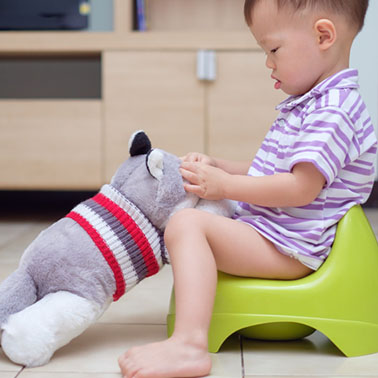What is toddler constipation?
Sometimes poo can become trapped in the colon (the last part of the bowel) and it becomes a hard, solid ‘stool’. This in turn leads to a blockage of the nerves between the brain and the bottom, so your child does not realise they need to go to the loo.
Of course, when it does finally make its way out, it can be hard and cause pain. Your toddler will remember that and may then get nervous of going to the loo again and the whole thing becomes a cycle.
How do we define constipation?
Constipation is defined as not having gone for a poo for at least three times in a week, having hard, large and pellet-like poo, straining on the loo, stomach pain and poor appetite and even blood in the loo as the poo is so large and hard.
How to spot toddler constipation
There are usually a few signs that will tell you your child is suffering from constipation; their poo is hard and pellet-like, they may strain or seem as if they are in pain on the loo and they may refuse to use the potty. They may also change their behaviour and go into a quiet corner.
What can cause constipation in young children?
There are several reasons why your child may become constipated including:
- Having a diet that is too low in high-fibre foods like vegetables and fruit
- If they are in a new environment like a nursery or school
- If they have underlying anxieties–anything from moving home to a new baby
- Not having enough to drink
- Being anxious about using the loo
- Feeling pressured to go to the loo, for example if you are trying to get out for the day
Lifestyle changes to help your toddler poo
How can you change things around to ensure your child can use the loo with ease? There are a few simple tips and swaps that can make things ‘go’ more easily:
Get them moving
Exercise can help your child’s digestive system work better, so keep them active.
Start a routine
Set some regular times to use the loo or potty, especially after meals and before bedtime.
Check they’re comfortable
Make sure your child’s potty is the right size for them and if they use the main loo, have a training seat and a stool to ensure they can sit comfortably with their feet flat on the floor
Talk to them
If there are certain situations that you know make your child anxious about using the potty or loo, such as at a friend’s or at nursery, talk them through this and try to make sure they go before and after these visits.
Try training pants
Introduce your toddler to Pull-Ups® to give them confidence and make them feel like a big kid at the same time.
Be prepared
Pack a bag with a change of clothing that your child takes with them if they are worried about having an accident when they are away from home.
Get help from Eric
Visit Eric, the Children’s Bowel & Bladder Charity to learn more about toddler constipation and healthy bowel and bladder movements.
Foods to help toddler constipation
The good news is there are types of foods that can prevent and even treat toddler constipation.
- Water – a simple remedy. Making sure your child has plenty of fluids is key to avoiding constipation
- Warm liquids like thin soup and milk – they are nutritious and easy to digest, plus they can help soften hard poo
- Probiotics – these microorganisms, often found in ‘live’ yoghurt and kefir. They help improve friendly gut bacteria and help to soften poo
- Beans and other pulses – these are very high in fibre, leading to good digestion
- Whole grains – whole grain cereals, bread and pasta are packed with insoluble fibre, which can speed up the time food takes to go through the gut
- Fresh fruit – like apples, pears, kiwis, figs, rhubarb, and grapes – they are high in fluid and fibre and contain substances including sorbitol and fructose, so are great foods to help toddler constipation
- Dried fruit like prunes – these are also high in fibre and contain gut-supporting sorbitol and phenolic compounds
- Vegetables – especially broccoli, which contains gut-easing sulforaphane. Sauerkraut is also good as it contains probiotics to help digestion
- Olive and flaxseed oil – these are mild laxatives and contain antioxidant and antibacterial qualities
When to see a doctor about toddler constipation
Usually, toddler constipation is nothing to worry about and resolves itself quickly, but if you are concerned, you can visit your GP for help and advice. Seek medical help if your child has pain or cramps in their tummy. Also speak to a doctor if your child’s poo is painful, hard, and dry. Your GP may suggest a laxative in addition to ensuring your child has a good diet, is well hydrated and is active. They may suggest a “disimpaction” routine at first if your child has been constipated for a while – this means increasing the laxative dose to clear all existing, hard poo.
Be aware that your child may have some leaking as softer poo leaks around the hard, impacted stools, so make you sure you have plenty of Huggies® Wipes and Pull-Ups® in stock.
For further advice, see more information from the NHS.
Potty training advice that’s right for your child
We know there’s a lot of information out there about potty training! It’s easy to feel confused about what advice to take. Whether you are unsure if your child is ready to start, or need help on the kit you need, we’ve done the research for you.


 your parenting partner
your parenting partner